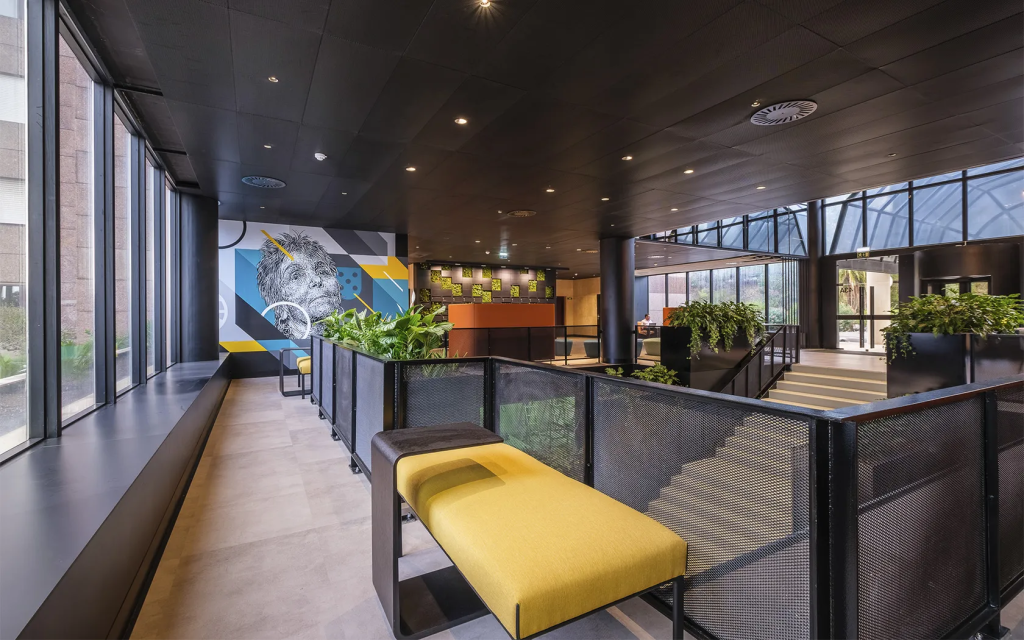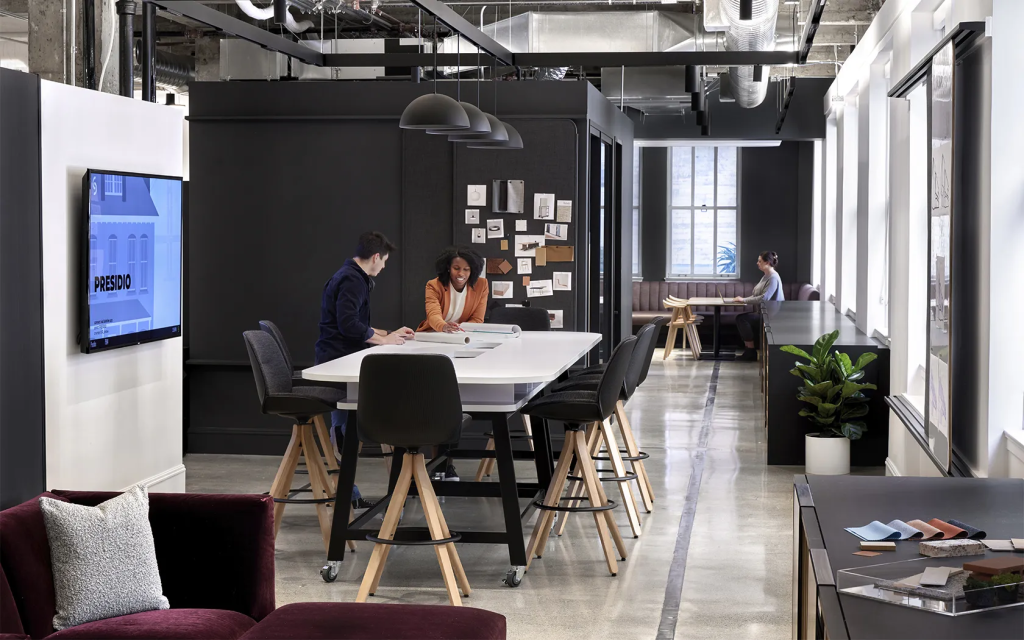The Office Reimagined – Design & Furniture Solutions for the Modern Workforce
Modern offices need to be as versatile as the workforces they accommodate. The future of work demands workplaces that attract top talent, boost well-being and spark collaboration.

Featured products: Raglan Modular Sofa and Arc Table from Andreu World
The past few years have fundamentally reshaped how we work. Pre-pandemic, offices were seen as essential for productivity and collaboration. Yet, the rise of remote work has challenged this notion, with estimates suggesting 20 to 25 per cent of workforces in advanced economies could work from home three to five days per week (according to a McKinsey analysis).
However, for many companies, the allure of a physical space to foster innovation, connection, and company culture remains. The key question for businesses today isn't whether they need an office but what kind of office will best serve their needs in a hybrid work environment while aligning with their company culture.
In this revamped work dynamics, companies must give employees a reason to choose the office. As per the 2024 Gensler Design Forecast, “organizations will continue to plan for in-person experiences in spaces that are agile and flexible enough to evolve with the changing demands of the workforce and useful enough to earn people’s commutes.”
A hot topic for architecture and design firms, as well as industry leaders, is how to design office spaces that meet the evolved needs of the workforce—which is a key consideration when it comes to staff retention. Simply replacing drab cubicles with sleek furniture or installing ping-pong tables won't be enough to lure employees back into the office.
Here is where interior design and furniture solutions come to the forefront. At KEZU, a leading supplier of commercial furniture, we are conscious that the future of the office lies in creating inspiring, flexible spaces that prioritise employee well-being and cater to the evolving needs of a hybrid workforce.
How to Design Spaces that Fit the Purpose of Today’s Workplace

Featured product: Nuez Stool from Andreu World
Gone are the days of monotonous cubicles and generic break rooms. Traditional workplace designs simply are no longer fit for purpose. Modern offices need to be as versatile as the workforces they accommodate.
The overarching goal isn't just about productivity; it's about fostering a space that fuels high performance and employee engagement. Employees need to feel more than just a cog in the machine; they crave spaces that communicate, “You’re not just a worker bee; you’re a valued team member.” This means creating an environment where people feel empowered, valued, and inspired to do their best work. Designers must go beyond functionality and consider employees' cultural and emotional needs.
Ideally, the design can even contribute positively to the environment, reflecting the company's commitment to sustainability.
Here are five key trends to consider when planning for modern workspaces:
1. Ditch the Desk Zoo - The Power of Multi-Functional Spaces
Think beyond the traditional desk layout. There is a growing shift from open floor plans entirely designed for focused work towards spaces that cater to a broader range of activities. Imagine designated zones for focused work, brainstorming sessions, casual meetings, and even relaxation. This empowers employees to choose the environment that best suits their task, boosting productivity and collaboration.
The key to multi-functional spaces lies in their adaptability. Ergonomic furniture is easily rearrangeable, allowing employees to tailor their workspace on the fly. Hot-desking, where employees don't have assigned desks, further encourages movement and interaction within the space. In essence, multi-functional workspaces prioritise connection, collaboration, and a thriving company culture.

|

|
|
Featured product: |
Featured product: |

|

|
|
Featured products: |
Featured products: |

|
|
|
Featured products: |

Featured product:
In Out Collection by Andreu World

Featured product:
In Out Collection by Andreu World

Featured products:
Adela Rex Chair by Andreu World
Forest Club Sofa by Andreu World
Flex Executive Chair by Andreu World

Featured products:
Carola Chair by Andreu World
Reverse Table by Andreu World

Featured products:
Lottus Chair by Enea
Lottus Stool by Enea
Pile Table by Enea
2. Biophilic Design - Nature's Secret Weapon
Studies consistently show that biophilic design significantly boosts employee well-being, with reports suggesting a 6% increase in productivity and a 15% jump in creativity (Human Spaces report).
Beyond just plants and calming water features, biophilic design extends to the very foundation of your workspace. Opt for furniture crafted from natural materials like wood and incorporate nature-inspired colors and textures. This holistic approach fosters a deeper connection to the outdoors, promoting not only focus and well-being, but also a sense of calm and inspiration.
Fresh air circulation is equally crucial. Aim for at least double the recommended amount to combat brain fog and enhance mental clarity. Additionally, the concept of "light equity" prioritises fair access to natural light for all employees. By creating office plans that maximise window access, you promote a more equitable and healthy work environment.

|

|
|
Featured product: |
Featured product: |

|

|
|
Featured product: |
Featured product: |

|
|
|
Featured product: |

Featured product:
Brandy Armchair
by
Andreu World

Featured product:
Bras Armchair
by
Artifort

Featured product:
Kaiak Office Chair
by
Enea

Featured product:
Brandy Armchair by Andreu World

Featured product:
Giro Sofa
by
Andreu World
3. Sustainability in Focus: Designing with the Planet in Mind
Environmental consciousness is a core value for many businesses and employees today. Integrating sustainable practices into the office design demonstrates your commitment to environmental stewardship and a greener future.
Furniture choices play a crucial role. Investing in high-quality, durable furniture is a cornerstone of sustainable workplace design, minimising the need for frequent replacements. Furthermore, prioritising furniture that can be updated or repaired, rather than replaced, aligns perfectly with the principles of a sustainable workplace design.
Beyond durability and repairability, the materials used in furniture manufacturing are equally important. Choosing recycled or recyclable materials ensures that furniture has a minimal environmental impact throughout its lifecycle. By embracing the principles of the circular economy, companies can support a closed-loop system where materials are reused, recycled, or repurposed, minimizing waste and conserving resources.

|

|
|
Featured product: |
Featured product: |

|
|
|
Featured product: |

Featured product:
Nuez Lounge BIO®
by
Andreu World
(Made with bioplastic of natural origin)

Featured product:
Tipo Chair
by
Axona Aichi
(Manufactured from 100% recycled materials, and can be 100% recycled)

Featured product:
Gala Chair Pure ECO®
by
Andreu World
(Andreu World only uses 100% Pure ECO® thermopolymers in the manufacture of its products, which guarantees circularity from their origin to the end of their useful life. This plastic, which is 100% recycled and 100% recyclable, has been used in their collections since 2024)
4. Tech that Blends, not Blinds
Seamless integration of technology like “Zoom Rooms” is crucial for effective communication between in-office and remote teams. However, tech integration should enhance, not dominate, the work experience.
Imagine a meeting room designed to feel more like a chic living room than a sterile conference space. A warm and inviting colour story, tasteful acoustic wall treatments, and comfortable seating all contribute to an environment that fosters conversation and collaboration. Technology is carefully integrated to be as unobtrusive as possible.
Furnishing choices also play a role in seamless technology integration. A boat-shaped table creates a more inclusive meeting space where remote participants feel like they are truly part of the conversation. Smartly placed chairs ensure everyone has a clear view of the screens and can actively participate. A space designed to function as a creative oasis can host everything from guest lectures to collaborative workshops, with flexible design and integrated technology.

|

|
|
Featured product: |
Featured products: |

|

|
|
Featured product: |
Featured product: |

Featured product:
Flex Executive Chair
by
Andreu World

Featured products:
Alya Executive Chair
by
Andreu World
Status Conference Table
by
Andreu World

Featured product:
Oru Chair
by
Andreu World

Featured product:
Shark Chair
by
Artifort
5. Bringing the "Home" Feeling to the Office
The concept of "resimercial" design is gaining traction. Employees seek work environments that feel comfortable and familiar, resembling an extension of their homes. This means incorporating softer furnishings, warm lighting solutions (research suggests circadian lighting with colour temperature adjustments can improve employee health and sleep!), and hospitality-inspired design elements. Think armchairs with built-in outlets, coffee shop-style high tables for casual meetings, and bookcases to add a touch of personality.

|

|
|
Featured products: |
Featured product: |

|
|
|
Featured product: |

Featured products:
Giro Sofa by Andreu World
Nuez Chair by Andreu World
Nuez Lounge BIO® by Andreu World
Reverse Tables by Andreu World
Quatro Occasional Table by Andreu World

Featured product:
Lottus Wood Chair
by
Enea

Featured product:
Lottus Stool
by
Enea
The Future of Work is Now
By embracing these design trends and furnishing your office with adaptable, functional, and sustainable furniture solutions, you can create a space that not only attracts top talent but also fosters a thriving company culture in the age of hybrid work.
KEZU is here to be your partner in creating the perfect office environment for your evolving needs. Contact us today to discuss your vision and explore our wide range of furniture solutions!

Your uniqueness can contribute to the world and the environment that you inhabit. It highlights your originality and authenticity and makes you stand out in a world full of conformity.

